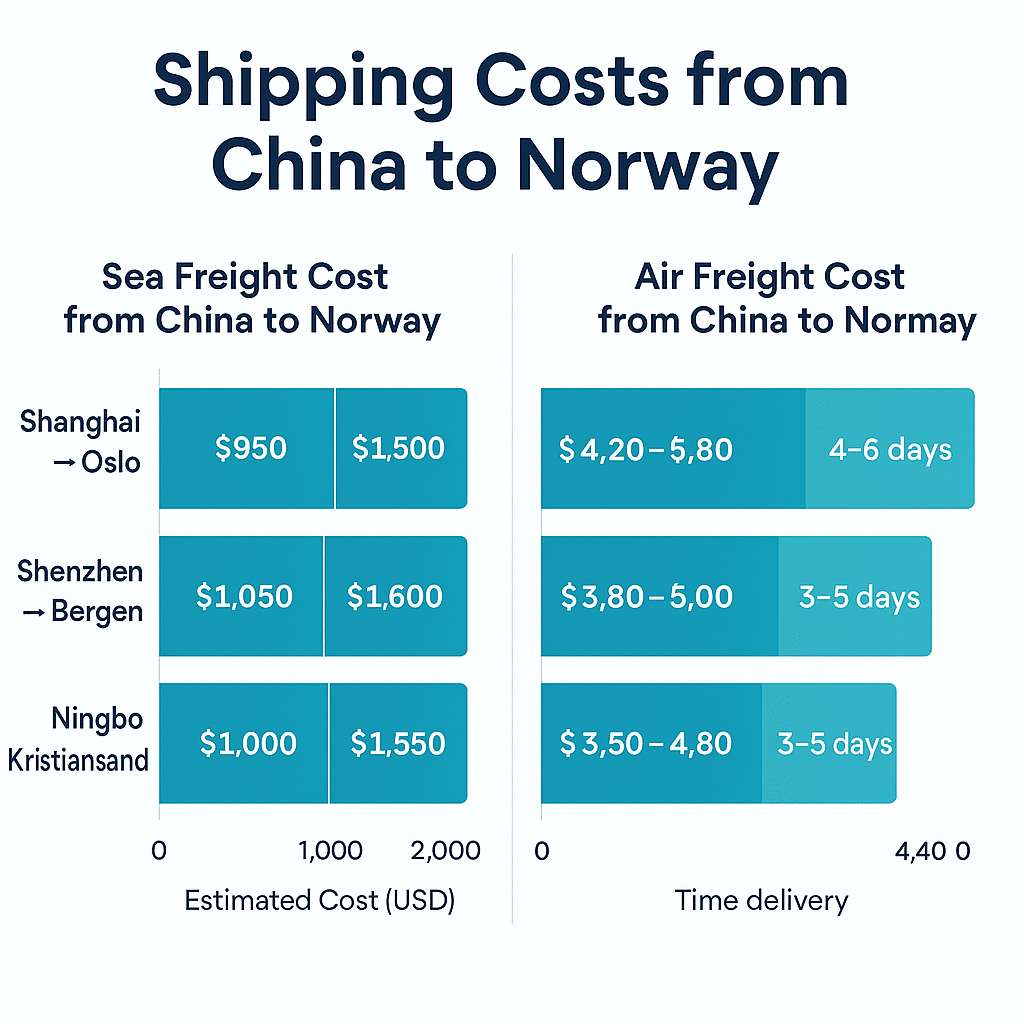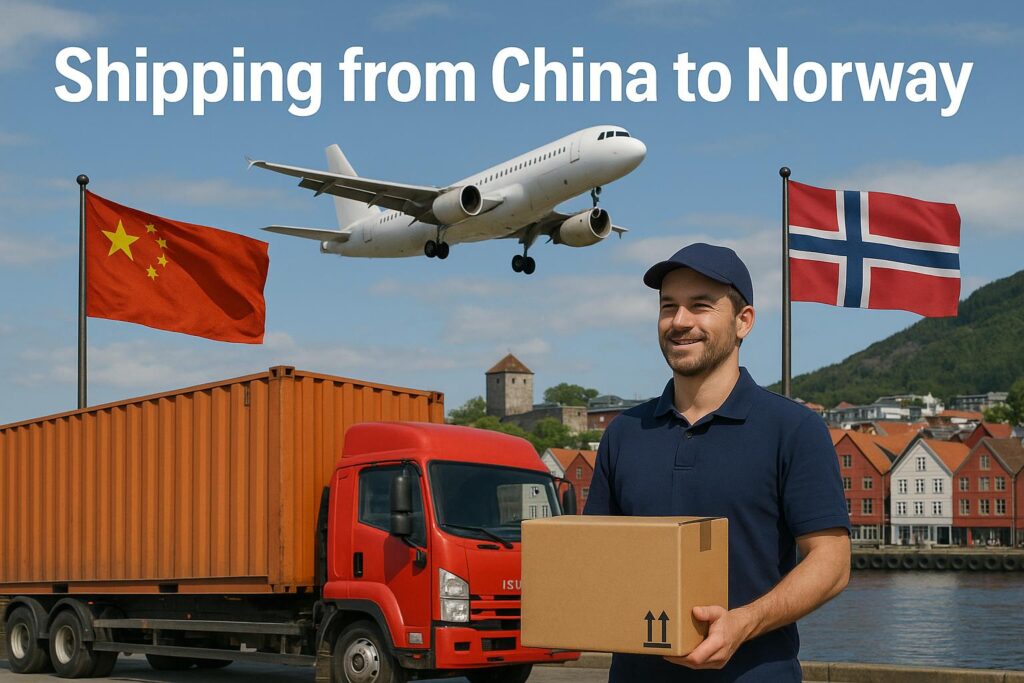Shipping from China to Norway has become an essential part of international logistics and global trade. As Norwegian businesses increasingly turn to Chinese manufacturers for affordable and high-quality goods, understanding the shipping methods, transit time, customs clearance, and shipping costs involved in moving cargo between China and Norway is more important than ever.
From air freight and sea freight to rail freight and door to door delivery, importers can now choose cost-effective and flexible solutions tailored to their business needs. Whether you’re shipping bulk goods via full container load or handling smaller shipments, this 2025 guide will help you navigate the shipping process with confidence.
With reliable freight forwarders, advanced tracking systems, and simplified customs procedures, shipping goods from China to Norway is faster, more affordable, and more transparent than ever before.

Shipping Methods from China to Norway
There are several shipping methods available for moving goods from China to Norway, each tailored to different budgets, delivery times, and cargo sizes. Choosing the right method depends on whether you prioritize shipping costs, timely delivery, or handling specialized cargo.
Sea Freight from China to Norway
Sea freight is the most commonly used option for bulk goods, containerized cargo, and large commercial shipments. It is especially cost-effective when dealing with full container load (FCL) or less than container load (LCL) options.
- FCL (Full Container Load): Ideal for large-volume shipments that fill a 20ft or 40ft container. This option offers better cost effectiveness and faster handling at ports.
- LCL (Less than Container Load): Suited for smaller shipments. Goods are consolidated with cargo from other importers, making it more economical for low-volume cargo.
Popular Origin Ports in China:
Shanghai, Shenzhen, Ningbo, Guangzhou, Qingdao
Major Ports in Norway:
Port of Oslo (Norway’s largest port), Port of Bergen, Port of Kristiansand
Sea freight typically takes 28–45 days depending on the port pairing and route.
Sea shipping is best for companies looking to reduce shipping costs while transporting non-urgent goods.
Air Freight from China to Norway
For time-sensitive shipments, air freight provides a much faster alternative to ocean shipping. Most cargo flights depart from southern China airports and arrive at Oslo Airport or other major Norwegian hubs.
Advantages of air freight:
- Faster transit time (3–7 days)
- Reliable air cargo tracking
- Suitable for electronics, apparel, and other time-sensitive shipments
Common Airports in China:
PVG (Shanghai), CAN (Guangzhou), PEK (Beijing), SZX (Shenzhen)
Arrival Airports in Norway:
OSL (Oslo Gardermoen), BGO (Bergen Airport)
Air freight may cost more per kg but helps avoid long delays and customs duties tied to slow clearance.
Dedicated cargo planes and established routes make air transportation a viable choice for small to mid-sized shipments.
Rail Freight from China to Norway
Rail transport is becoming increasingly popular thanks to China’s Belt and Road Initiative. Goods are transported overland from China through Russia, Belarus, and Poland before reaching Northern Europe, including Norway.
- Transit time: 15–25 days (faster than sea, cheaper than air)
- Best for mid-sized container load cargo
- Often used in multimodal shipping with final delivery by truck
Rail freight is ideal for companies needing a balance of speed, cost, and sustainability.
Express Shipping (Courier Services)
For lightweight or high-value shipments, express shipping via courier companies like DHL, FedEx, UPS, or SF Express offers door to door delivery in just 3–5 business days.
Benefits include:
- End-to-end real-time tracking
- Customs clearance support
- Convenient pick-up from supplier warehouse in China
- Delivery to final address in Norway
While more expensive than sea or rail freight, it is ideal for eCommerce, sample shipments, or urgent deliveries.
Shipping Costs from China to Norway
Understanding shipping costs from China to Norway is essential for budgeting and choosing the most suitable transportation method. Rates can vary widely depending on factors like cargo size, weight, route, delivery urgency, and choice of freight forwarder.
Factors That Influence Shipping Costs
Here are the key elements affecting shipping rates:
- Mode of transport: Air freight is more expensive than sea freight, while rail freight is a middle-ground option.
- Weight and volume: Carriers use chargeable weight (whichever is greater: actual or volumetric) to calculate air cargo rates.
- Route and destination: Direct routes usually offer lower costs compared to transshipment options.
- Customs clearance fees: Including import duties, VAT, and inspection fees.
- Insurance costs: Recommended for valuable or fragile cargo.
- Fuel surcharges and peak season adjustments
A reliable freight forwarder can help you coordinate multiple carriers, optimize shipping methods, and reduce unnecessary costs.
Sea Freight Cost from China to Norway
| Route | 20ft Container | 40ft Container | Transit Time |
|---|---|---|---|
| Shanghai – Oslo | $950 | $1,500 | 35–42 days |
| Shenzhen – Bergen | $1,050 | $1,600 | 38–45 days |
| Ningbo – Kristiansand | $1,000 | $1,550 | 33–40 days |
Sea freight is ideal for bulk cargo and container load shipments that are not time-sensitive.
Air Freight Cost from China to Norway
| Weight Range | Air Freight Rate (USD/kg) | Estimated Delivery |
|---|---|---|
| 100 – 300 kg | $4.20 – $5.80 | 4 – 6 days |
| 300 – 500 kg | $3.80 – $5.00 | 3 – 5 days |
| 500 kg and above | $3.50 – $4.80 | 3 – 5 days |
Air freight is best for time-sensitive shipments, product launches, or high-value goods like electronics and medical equipment.
Express Courier Shipping Rates
| Courier Service | Weight (10 kg) | Estimated Cost | Delivery Time |
|---|---|---|---|
| DHL Express | $80 – $110 | 3 – 5 days | |
| FedEx International | $75 – $105 | 3 – 5 days | |
| UPS Worldwide | $70 – $100 | 3 – 5 days |
These rates are estimates. Actual pricing depends on pickup location, packaging, and current international shipping conditions.
Tip:Use our CBM Calculator and Chargeable Weight Tool to get an accurate quote before shipping. They help you compare air and sea freight options side-by-side based on your cargo dimensions.
Learn more:
- Shipping Cost from China to Egypt
- Shipping from China to Los Angeles
- Shipping from China to Italy
- Cost to Ship a Car to Jamaica from China
- Shipping Cost from China to Netherlands
- Shipping from China to Serbia
- Shipping Cost from China to Ireland
- Shipping Cost from China to the USA

Customs Clearance in Norway
Efficient customs clearance is a vital step when shipping goods from China to Norway. All imports must be declared to Norwegian customs authorities, and the correct paperwork must be submitted to ensure smooth entry into the country. Delays, penalties, or cargo holds can occur if the process is not handled correctly.
Required Documents for Importing into Norway
To comply with customs regulations, the following documents are usually required:
- Commercial Invoice – Must detail product description, HS codes, declared value, and origin.
- Packing List – Lists quantity, weight, and packaging types.
- Bill of Lading (for sea freight) or Air Waybill (for air freight)
- Certificate of Origin – Sometimes required to verify the goods’ origin.
- Import License – For controlled or restricted goods.
- Delivery Instructions – For door to door shipping or if using a third-party logistics partner.
Having accurate and complete documentation helps you navigate customs smoothly and avoid unexpected fees.
Import Duties and VAT in Norway
Norway is not a member of the European Union but follows many EU trade practices through the EEA agreement. Therefore, importers are still required to pay:
- Import duties: Based on the product’s HS code and customs value. Most industrial goods from China are subject to low or zero duties.
- VAT (Value Added Tax): Standard rate is 25%, calculated on the sum of the product cost, shipping cost, insurance, and duties.
Some items (such as books or food) may have a reduced VAT rate or be exempt.
Customs Authorities and Import Requirements
Norwegian Customs (Toll.no) oversees all import-related procedures. To import goods as a business entity, you will need:
- A valid Norwegian organization number
- EORI registration for cross-border trade
- Knowledge of product-specific rules (such as specialized cargo, electronics, or chemicals)
For faster clearance, consider working with an experienced freight forwarder or customs broker familiar with China to Norway trade routes.
Tips for Smooth Customs Clearance
- Use a Delivered Duty Paid (DDP) service if you want the forwarder to handle all customs and taxes on your behalf.
- Ensure your commercial invoice is consistent with the declared HS code.
- Avoid using vague terms like “sample” or “gift” without proper value and description.
- Check whether your product qualifies for preferential duty under free trade agreements or cost-effective regimes.
Door to Door Shipping from China to Norway
Door to door shipping from China to Norway is the most convenient solution for importers who prefer an all-inclusive logistics service. This method handles every stage of the shipping process, from factory pickup in China to final delivery at your warehouse, office, or home in Norway—minimizing delays, paperwork, and coordination stress.
What’s Included in Door-to-Door Shipping?
A professional freight forwarder will manage:
- Pickup from the supplier’s warehouse or factory in China
- Export customs clearance at the origin port/airport
- International shipping via air freight, sea freight, or rail freight
- Import customs clearance in Norway (including customs duties and VAT if using DDP)
- Final delivery to the consignee’s address in Oslo, Bergen, or anywhere across Norway
This shipping service is especially useful for small to mid-sized businesses, eCommerce sellers, and Amazon FBA resellers.
Who Should Choose Door to Door Delivery?
- First-time importers unfamiliar with Norwegian customs procedures
- Businesses that want simplified logistics without dealing with multiple carriers
- Companies seeking timely delivery without hidden fees
- Buyers of bulk goods, electronics, furniture, and consumer products
It’s a cost-effective solution when factoring in time savings, fewer delays, and minimal customs risks.
Transit Times for Door to Door Shipping
| Shipping Method | Estimated Time (DDP) |
|---|---|
| Air Freight (DDP) | 7 – 12 days |
| Sea Freight (DDP) | 35 – 50 days |
| Rail Freight (DDP) | 20 – 30 days |
The final timeline depends on cargo volume, destination city, and customs clearance efficiency.
Advantages of Door to Door Shipping
- Full logistics coordination through one service provider
- Predictable total costs with Delivered Duty Paid options
- Better control over container load optimization
- Improved customer satisfaction with faster processing and real-time tracking
Whether shipping fragile electronics or heavy containerized cargo, door to door delivery ensures your shipment arrives safely and smoothly at its destination.

Conclusion: Choosing the Best Shipping Solution from China to Norway
Shipping from China to Norway can be straightforward and cost-effective when you understand the available shipping methods, manage customs clearance properly, and work with a trusted freight forwarder.
Whether you’re handling bulk shipments via sea freight, moving fast inventory through air freight, or need door to door delivery for hassle-free logistics, your shipping strategy should be tailored to your cargo type, timeline, and budget.
With China’s extensive export capabilities and Norway’s efficient ports and infrastructure, importers can benefit from faster routes, lower risks, and competitive shipping costs—all while ensuring customer satisfaction.
Frequently Asked Questions (FAQ)
What is the cheapest way to ship from China to Norway?
The most cost-effective method is sea freight (FCL or LCL), especially for large-volume goods. For small parcels, LCL shipping or even postal service may offer better value.
How long does shipping from China to Norway take?
- Air freight: 3–7 days
- Sea freight: 28–45 days
- Rail freight: 15–25 days
- Door to door shipping (DDP): 7–50 days depending on method
Do I need a customs broker to import goods into Norway?
Not always. If you work with a full-service freight forwarder, they often include customs clearance support. For more complex shipments, hiring a customs broker familiar with Norwegian customs is recommended.
Is DDP shipping to Norway a good option?
Yes. Delivered Duty Paid (DDP) means your logistics provider handles import duties, VAT, and all paperwork. This simplifies the process and ensures your cargo clears borders with minimal delays.
Which shipping method is best for urgent goods?
Air freight or express courier services like DHL or FedEx are ideal for time-sensitive shipments, though they cost more than ocean or rail.
Work with a Trusted Freight Forwarder for China to Norway Shipments
At Tonlexing, we offer end-to-end logistics services to help you ship from China to Norway with ease. Whether you need:
- FCL or LCL sea freight
- Fast air freight
- Rail freight via China–Europe routes
- DDP or door-to-door delivery
- Customs clearance support
We tailor the most suitable and cost-effective shipping solution for your cargo.
Get a Free Shipping Quote Now
Contact us via WhatsApp or Email, and our logistics team will help you simplify your international shipping from China to Norway today.


